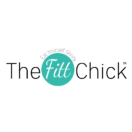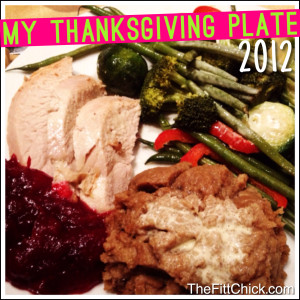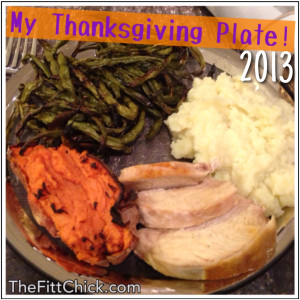Mashed potatoes, stuffing, pumpkin pie: Thanksgiving is the day that many of us eat anything (and everything) we want. With the average Thanksgiving meal running well over 4,000 calories, it can be hard to manage the day when you’re watching your weight or counting calories. To make the day healthy, enjoyable, but still indulgent, check out how yummy my Thanksgiving meals looked over the last few years. I was filled to the brim, completely satisfied, and totally on plan, even when I wasn’t in charge of the cooking! (Although I did bring a few FittChick “approved’ side dishes to add to the buffet).
Check out these tips from PopSugar to help you enjoy your meal without packing on the pounds!
“Use a Smaller Plate
Studies show that food intake is related to plate size. We’re taught to fill our plates and eat every last morsel from them; very often we finish our food before that “full feeling” even has a chance to reach us. Prevent mindless eating by using a smaller plate at dinner (aim for a plate that’s between eight and 10 inches); if your host doesn’t have a smaller plate, don’t feel the need to entirely cover the one you are using or have to finish everything you served yourself.
Think About Portions
The last thing you want to do is to feel like you are depriving yourself on Thanksgiving, so don’t. Instead of telling yourself certain foods are off limits, just be smart about your serving sizes. Avoid making huge piles on your plate; instead, give yourself a small taste of everything with an emphasis on whole grains, veggies, and protein. Need a little more guidance? Follow these tips for getting portions under control.
Load Up on Veggies
First off, green bean casserole and mashed potatoes aren’t really what we’d consider a veggie. An easy way to eat healthier on Thanksgiving is to fill up on fresh, whole veggies — aim to cover almost half of your plate. We’re talking salad, roasted veggies, or a simple pureed soup. Doing so will provide you with a rainbow of nutrients while also giving you more calorie bang for your buck — you’ll eat more but gain less. And, since you’re filling up on fresh veggies, you’re less likely to go overboard on everything else.
Limit Yourself to One Starch or Unhealthy Item
If bite-size portions aren’t your thing, or there is a Thanksgiving staple you can’t live without, limit yourself to one unhealthy item. After serving yourself an ample amount of veggies, a good serving of protein (three to four ounces — about the size of a deck of cards), finish your plate off with the indulgence of your choice, whether it be mashed potatoes, candied yams, or green bean casserole.
Not All Turkey Meat Is Created Equal
When it comes to the bird, the easiest way to save on calories and fat is to choose skinless meat. White meat is lower in calories than dark meat, but if you’re skipping out on calorie-laden gravy, a little dark meat on your plate might be a good thing. It tends to be more flavorful and juicy; it also contains more iron than white meat does. Here is a nutritional comparison of white and dark turkey meat.
Hold the Sauce (and Gravy and Creams . . .)
With a few exceptions, most condiments and sauces tend to be calorie-laden because of their sugar, dairy, or fat content. If possible, pass on any rich sauces or creams that might be served: say no to gravy, skip slathering your bread in butter, and enjoy that pumpkin pie sans whipped cream.
Pare Down the Dessert Course
Thanksgiving dinner really isn’t complete until dessert has been served. Instead of trying every single item on the dessert table, pick one to enjoy for the evening. Or, make yourself a dessert sampler: split a few desserts among friends, or slice yourself small slivers from each dessert. Also, if you’re stuffed from dinner, skip dessert and pack a piece of pie to take home with you.”
Eat Yourself Skinny!
Related Posts
Healthy Holiday Tips for a Thinner Thanksgiving!



